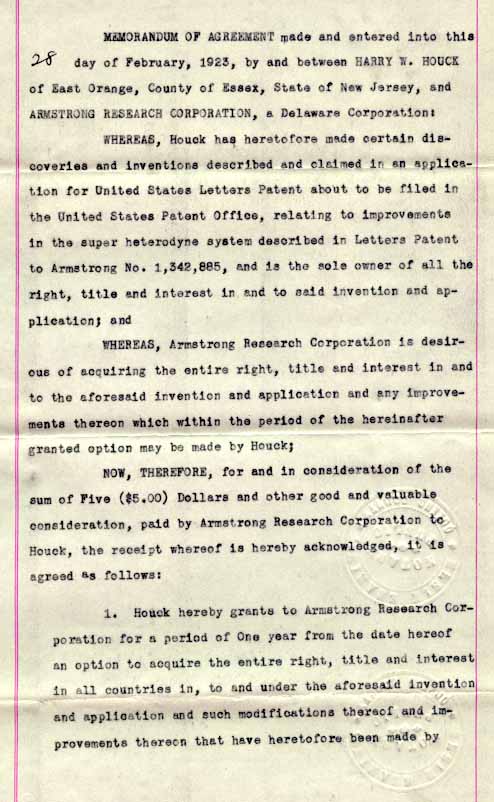
By 1923 the nation had gone broadcast crazy. In
1922 there had been 100,000 radio receivers produced, by 1923
that number stood at 500,000. In 1922 there were 30 radio
stations on the air, by 1923 there were 556 on the air. It would
be no exaggeration to say that the inventions of Armstrong were
in a big way responsible for this enormous growth.
Armstrong had not been ignoring his superheterodyne. He realized
early on his invention could be the answer to the long felt need
for a sensitive, easy to operate broadcast receiver. Through his
winning court battle with de Forest, his feed-back and
superheterodyne negotiations with Westinghouse and his
superregenerative negotiations with RCA, Armstrong had been
developing his superheterodyne into a commercially doable
reality.
Harry Houck, who had impressed Armstrong in France with his
ability to turn ideas into hardware, would be a key player in
taming this circuit - and tame it they did.
By early 1923 Armstrong had demonstrated a five tube set to the
Vice President of RCA, David Sarnoff. To say Sarnoff was
impressed would be an understatement. Sarnoff saw this as the
receiver which would guarantee RCA sales leadership and stop
'encroachment' of its market share by the likes of Atwater Kent.
Also weighing heavily on his mind was the fact that AT&T, a
potential competitor in receiver manufacturing, had recently
submitted a superheterodyne to RCA for evaluation.
In fact, Sarnoff and the RCA board of directors were so impressed
with Armstrong's equipment that the million dollar orders placed
just two days before, to Westinghouse and GE, to cover the '23 -
'24 Christmas season, were canceled. Sarnoff's plan was to scoop
the following season. They did - the superheterodyne introduced
in February of 1924 was a runaway success.
Sketches, on the front and back of a paper scrap, by Armstrong (first) and Houck (second), made during development of the pre-production superheterodyne.


Besides actually building all of the pre-production models, Harry Houck's main contribution, to what would become the first RCA production superhet, would be his second harmonic invention. There were several inherent advantages to this scheme - reduction of one tube by combining the functions of oscillator and first detector; elimination of antenna radiation, and; reduced interaction between antenna and oscillator controls. Houck saved an additional tube by reflexing the first IF amplifier back through the RF amplifier.
Drawing from Houck's second harmonic patent, #1,686,005, issued on October 2, 1928.

Harry Houck would eventually receive at least
$100,000.00 from Armstrong for his work on the superheterodyne.
Just a few days before filing for his second harmonic patent,
Houck assigned rights to Armstrong.
